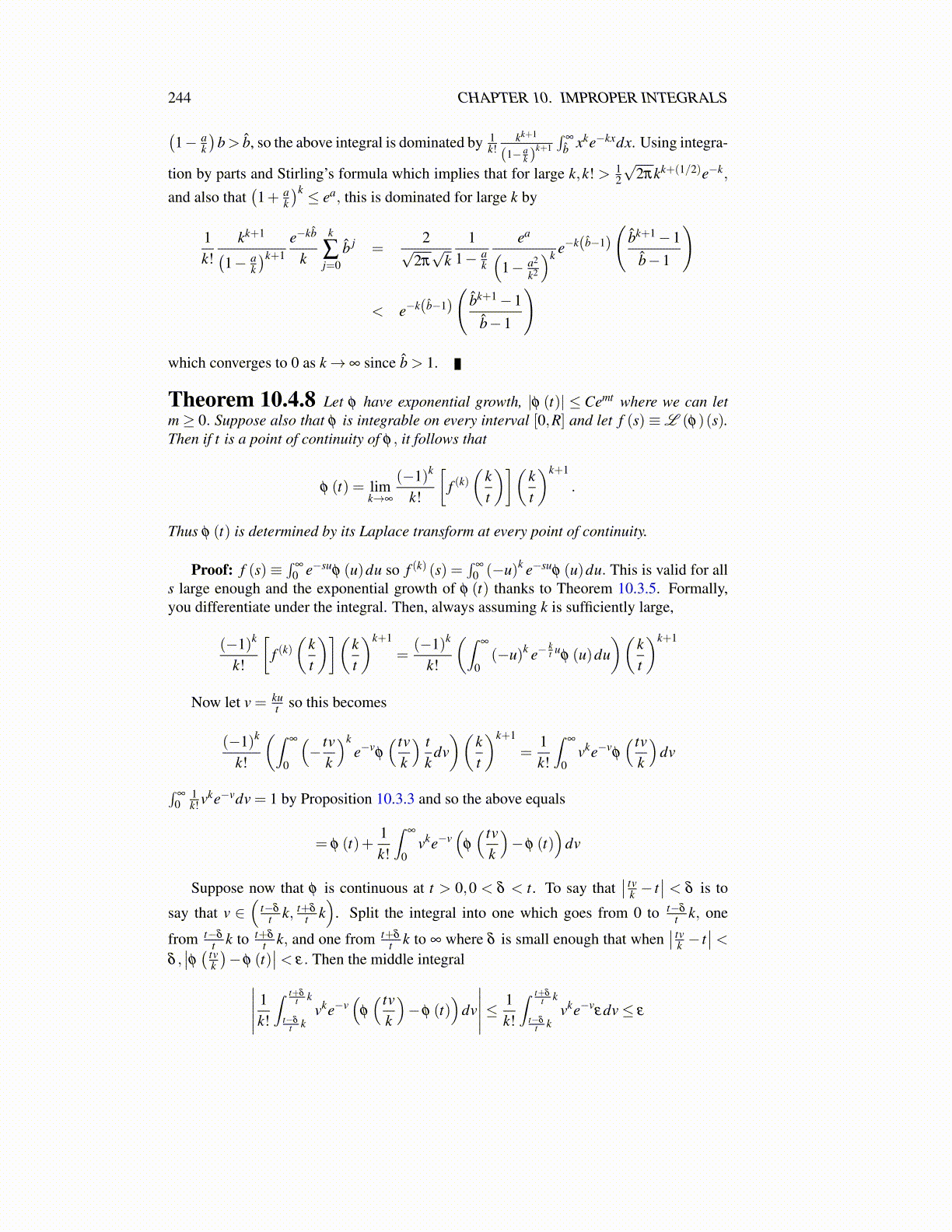
244 CHAPTER 10. IMPROPER INTEGRALS
Proof: First note that limt→∞ |φ (t)|= 0. Next change the variable letting x = e−t and sox ∈ [0,1]. Then this reduces to
∫ 10 xs−1φ (− ln(x))dx. Now if you let q(x) = φ (− ln(x)) , it
is not defined when x= 0, but x= 0 corresponds to t→∞. Thus limx→0+ q(x)= 0. Definingq(0)≡ 0, it follows that it is continuous and for all n = 0,1,2, · · · ,
∫ 10 xnq(x)dx = 0 and so
q(x) = 0 for all x from Lemma 10.4.9. Thus φ (− ln(x)) = 0 for all x ∈ (0,1] and soφ (t) = 0 for all t ≥ 0.
Now suppose only that |φ (t)| ≤ Ceλ t so φ has exponential growth and that for all ssufficiently large, L (φ) = 0. Does it follow that φ = 0? Say this holds for all s≥ s0 wherealso s0 > λ . Then consider φ̂ (t)≡ e−s0tφ (t) . Then if s > 0,∫
∞
0e−st
φ̂ (t)dt =∫
∞
0e−ste−s0t
φ (t)dt =∫
∞
0e−(s+s0)tφ (t)dt = 0
because s+ s0 is large enough for this to happen. It follows from Lemma 10.4.10 thatφ̂ = 0. But this implies that φ = 0 also. This proves the following fundamental theorem.
Theorem 10.4.11 Suppose φ has exponential growth and is continuous on [0,∞).Suppose also that for all s large enough, L (φ)(s) = 0. Then φ = 0.
This proves the case where φ is continuous. Can one still recover φ at points of con-tinuity? Suppose φ is continuous at every point but finitely many on each interval [0, t]and has exponential growth and L (φ)(s) = 0 for all s large enough. Does it follow thatφ (t) = 0 for t a point of continuity of φ? Approximating with finite intervals [0,R] in placeof [0,∞) and then taking a limit, (details left to you.)
0 =∫
∞
0e−st
φ (t)dt = e−st∫ t
0φ (u)du|∞t=0 + s
∫∞
0e−st
(∫ t
0φ (u)du
)dt
The boundary term is 0 for large s because∣∣∣∣∫ t
0φ (u)du
∣∣∣∣≤ ∫ t
0|φ (u)|du≤
∫ t
0Ceλudu =
Cλ
(eλ t −1
)≤ C
λeλ t
Therefore, 0=∫
∞
0 e−st(∫ t
0 φ (u)du)
dt and by Theorem 10.4.11,∫ t
0 φ (u)du= 0 for all t > 0.Then by the fundamental theorem of calculus, Corollary 9.5.6, g′ (t) = φ (t) = 0 at everypoint of continuity. This proves the following theorem.
Theorem 10.4.12 Suppose φ has exponential growth having finitely many pointsof discontinuity on every interval of the form [0,R]. Suppose also that for all s large enough,L (φ)(s) = 0. Then φ (t) = 0 whenever φ is continuous at t.
Note that this implies that if L φ = L ψ then, L (φ −ψ) = 0 so φ = ψ at all points ofcontinuity.
10.5 Exercises1. Prove Lemma 10.4.5 by considering
F (z)≡∫ z
0
∫ t
0f (t−u)g(u)dudt−
∫ z
0
∫ z
uf (t−u)g(u)dtdu.
Explain why F (0) = 0 and use the first mean value theorem for integrals to showthat F ′ (z) = 0 for z > 0. Generalize to f ,g are piecewise continuous.